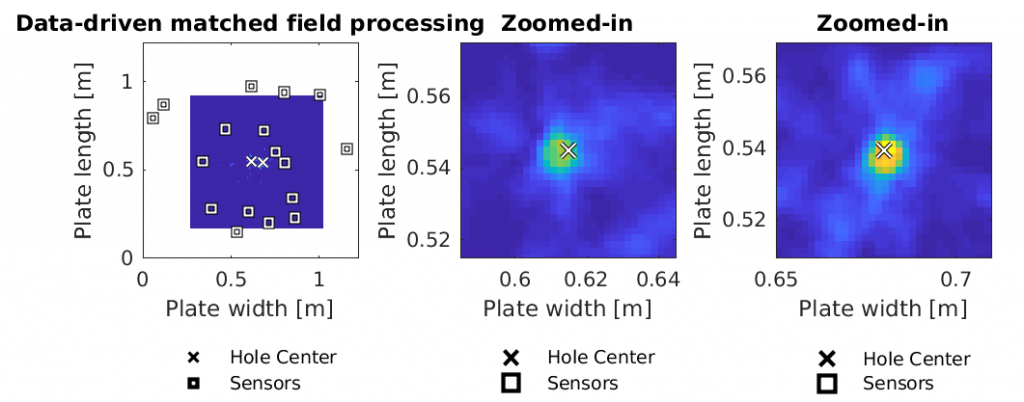Data-Driven Matched Field Processing (DDMFP) Repository

Summary
Data-Driven Matched Field Processing (DDMFP) is an innovative signal processing framework designed for localizing acoustic sources in complex environments, such as those encountered in structural health monitoring (SHM) using Lamb waves. Traditional matched field processing (MFP) techniques rely heavily on accurate physical models of the propagation medium, which can be challenging to obtain in real-world scenarios. DDMFP circumvents this limitation by constructing localization models directly from measured data, enhancing robustness and accuracy in complex, multimodal propagation environments.
This repository provides a comprehensive, reproducible implementation of the DDMFP algorithm, based on the foundational work:
- Harley, J. B., & Moura, J. M. F. (2014). Data-driven matched field processing for Lamb wave structural health monitoring. The Journal of the Acoustical Society of America, 135(3), 1231–1244. https://doi.org/10.1121/1.4863651
🧭 Problem Addressed by DDMFP
In SHM applications, accurately localizing damage or acoustic sources is crucial. Traditional MFP methods compare measured signals to simulated responses based on physical models of the medium. However, these methods falter when the medium’s properties are complex or poorly understood, leading to significant localization errors.
DDMFP addresses this challenge by eliminating the dependency on physical models, instead utilizing empirical data to construct a dictionary of signal responses corresponding to known source locations. This data-driven approach enhances localization accuracy, particularly in environments with complex wave propagation characteristics.
🧠 Core Methodology
DDMFP operates by comparing new measurements to a library of previously recorded signals from known locations. The algorithm identifies the source location by finding the best match between the new measurement and the entries in the data-driven dictionary.
Mathematically, the localization problem is formulated as:
![]()
Where:
 is the new measurement vector from
is the new measurement vector from  sensors.
sensors. is the dictionary matrix containing
is the dictionary matrix containing  training measurements from known locations.
training measurements from known locations. is a sparse vector indicating the likelihood of each location being the source.
is a sparse vector indicating the likelihood of each location being the source. is a regularization parameter promoting sparsity in
is a regularization parameter promoting sparsity in  .
.
The solution ![]() reveals the most probable source location(s), with non-zero entries indicating potential matches.
reveals the most probable source location(s), with non-zero entries indicating potential matches.
⚙️ Repository Contents
- Algorithm Implementation: MATLAB code for executing the DDMFP algorithm.
- Sample Datasets: Synthetic and experimental datasets for testing and validation.
- Tutorials: Step-by-step guides to understand and utilize the algorithm effectively.
- Visualization Tools: Scripts for visualizing localization results and comparing them with traditional methods.
✅ Advantages of DDMFP
- Model-Free Localization: Eliminates the need for complex physical models of the propagation medium.
- Enhanced Accuracy: Demonstrates superior localization performance in complex environments compared to traditional methods.
- Robustness: Maintains performance in the presence of multipath interference and environmental uncertainties.
- Versatility: Applicable to various domains, including SHM, underwater acoustics, and medical imaging.
📚 Reference
Harley, J. B., & Moura, J. M. F. (2014). Data-driven matched field processing for Lamb wave structural health monitoring. The Journal of the Acoustical Society of America, 135(3), 1231–1244. https://doi.org/10.1121/1.4863651
Eigenmodes Imaging Lamb Wave Linear Algebra Localization Matched Field Processing Structural Health Monitoring

